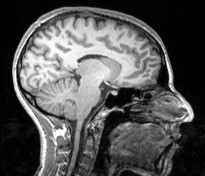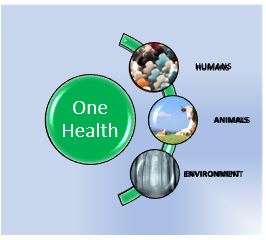One Health Newsletter
A One Health Perspective: COVID-19’s Neuroscientific Aspect
Author
Maxwell Amoako
Department of Neuroscience
Georgetown University
Washington, DC, USA
Introduction
In simple terms, coronaviruses are large, enveloped RNA viruses.1 Among all RNA viruses, coronaviruses possess the largest genome.1 These viruses are placed under the Coronaviridae family and are classified under the following genera: Alphacoronavirus, Betacoronavirus, Deltacoronavirus, and Gammacoronavirus.1 Severe acute respiratory syndrome coronavirus 2 (SARS-CoV-2) is a betacoronavirus that caused the coronavirus disease 2019 (COVID-19) pandemic. Based on disease transmission, alpha and betacoronaviruses infect only mammals, deltacoronaviruses infect both birds and mammals, and gammacoronaviruses infect only birds.1
The coronavirus viral genome is encapsulated by a nucleocapsid protein and further covered by a viral envelope.1 The envelope protein and membrane protein facilitate virus assembly, while the spike proteins permit viral entry into target cells.1 The coronavirus spike protein is composed of three sections: an ectodomain (with the receptor-binding S1 subunit and fusion S2 subunit), a transmembrane anchor, and an intracellular tail.1 The coronavirus spike protein exists in two forms: the prefusion trimeric spike (with three receptor-binding S1 heads) and the post-fusion trimeric spike (with a S2 six-helix bundle with fusion peptides).1 SARS-CoV-2 can invade target cells by using spike protein binding of the angiotensin-converting enzyme 2 receptor (ACE2R).3 ACE2 cleaves angiotensin-2 (ang-2), which leads to blood pressure elevation through the induction of vasoconstriction, increase of renal sodium reabsorption, increase of water absorption, and stimulates thirst. This cleavage transforms ang-2 into the vasodilator peptide ang-(1-7), which helps ACE2R counteract the ACE/ang-2/AT1R axis.2 Given the name coronavirus (corona meaning ‘crown’ in Latin), the RNA viral surface is studded with spike proteins that bestow a crown-like appearance.1 Based on numerous recent case studies, some COVID-19 patients have reported various neurological symptoms in specific brain regions (Figure 1).
COVID-19 and Neuroscience
Coronavirus infections have the ability to induce neurological and neuromuscular symptomologies in patients.3 SARS-CoV-2’s mechanisms for secondary neurological disease are not well understood, but some studies suggest that the brainstem is potentially involved in trans-neuronal viral transmission.3 Additionally, like lung alveolar epithelium, ACE2R is also expressed in the central nervous system (CNS), which could allude to the potential neurotropic properties of SARS-CoV-2.2, 4 Given ACE2R expression in the upper airway epithelium, SARS-CoV-2 can traverse to the CNS via nasopharyngeal mucosal and spread through the cribriform plate.3 Some COVID-19 cases have reported skeletal muscle injury, acute cerebrovascular disease, and epilepsy.5 The following neurological symptoms were observed from individual case studies: altered mental status, headache, seizure, neck stiffness, ankle clonus, diplopia, perioral paresthesia, gait instability, anosmia, and ageusia.5
Figure 1: Brain Magnetic Resonance Imaging. Credit: Kindly provided by Shiva Hassanzadeh-Behbahani (Doctoral Student, Doctor of Philosophy in Neuroscience, Georgetown University).
To treat some COVID-19-related neurological symptoms, clinicians have considered intravenous immunoglobulin (IVIG) therapy to decrease cytokine storms and diminish vasogenic edema.5 For seizures, clinicians have considered management using antiepileptic drugs, viral protease inhibitors (e.g. ritonavir and lopinavir), anti-inflammatory drugs, and antiparasitic drugs.5 COVID-19 patients have displayed hypercoagulability and thromboembolism, which suggests a need for venous thromboembolism prophylaxis.5 Based on individual case studies involving neurological symptoms, some additional COVID-19 treatments were also administered, including vancomycin, acyclovir, meropenem, laninamivir, ceftriaxone, favipiravir, ribavirin, and arbidol.5
COVID-19 and One Health
One Health is described as a multidisciplinary approach to obtain optimal health by acknowledging the connectivity between animals, humans, and the environment.2 Figure 2 highlights the triad (i.e., humans, animals, and the environment) that underlies the One Health model.6 This approach is not a new concept, but it has become more important due to changes in interaction.2 Human populations are expanding into new regions, and therefore, they are getting in closer contact with animals that could transmit diseases.2 Climate change and land use (e.g. deforestation and intensive farming practices) can provide more opportunities for diseases to pass onto animals.2 International travel can allow disease to spread quicker across borders and around the world.2 Some One Health issues include zoonotic diseases (like COVID-19) and mental health2, which pertains to neurological aspects of SARS-CoV-2 infection.
Figure 2: Image depicting the One Health concept. Credit: M. Amoako created the figure with Microsoft Word Stock Image Library.
SARS-CoV-2 likely originated from bats, which permitted transmission to humans through an intermediate host not clearly identified.7 This virus has been reported to spread to mink farms in Denmark, Spain, Italy, Sweden, Greece, and the United States.7 Infected farmworkers were suggested to be the primary source of mink infections, and the U.S. Department of Agriculture (USDA) had used the One Health approach to create guidelines to protect the health of animals and workers.7 Additionally, the Centers for Disease Control and Prevention (CDC) has developed One Health teams for numerous state and local departments to investigate farms and viral transmission between mink, humans, and other animals.7 Using the National Veterinary Services Laboratories, the USDA created a list of all animals and mink farms in the United States that are positive for SARS-CoV-2.7 Now, the CDC and its partners are performing serosurveillance studies of the virus in pets that have come into contact with COVID-19 patients.7 By conducting serosurveillance studies, the CDC tests the animals to observe if they developed antibodies to the virus and to understand the role of pets in viral transmission.7
Conclusion
Overall, with the zoonotic transmission of the SARS-CoV-2 virus, One Health seems to be an invaluable approach in this pandemic. The expertise in human health (nurses, epidemiologists, public health workers, and doctors), environmental health (wildlife experts and ecologists), and animal health (agricultural workers and veterinarians) underscore how diverse disciplines can converge on a common problem (e.g. COVID-19 pandemic).2 Inclusion of neurologists, neuro-microbiologists, neuroscientists, neuropsychologists, and neurosurgeons are important examples of how neuroscience (a specific field) applies to the One Health approach by using their expertise to create solutions for neurological COVID-19 symptoms. By focusing on humans, animals, and the environment, One Health helps people realize how one action causes a more holistic approach to a world problem. The SARS-CoV-2 neurological mechanism is not entirely understood, and so, perhaps the One Health approach will help researchers understand how the virus specifically compromises the human brain. Since SARS-CoV-2 affects the brain, scientists should perform more research to ascertain the relationship between SARS-CoV-2 exposure and the enteric nervous system. It is possible that the virus may affect the neuronal firing rates of certain neurotransmitters (e.g. glutamate, GABA, serotonin, glycine, dopamine, and acetylcholine) to cause COVID-19’s neurological symptoms. COVID-19 affect on the neurologic system provides a unique aspect for One Health and should be further considered for future COVID-19-related One Health programs and an area of future research funding. As one of the most complex organ systems of the body, studies of the brain as it relates to SARS-CoV-2 could unveil more secrets and improved understanding of its effects through the support of multidisciplinary collaboration using the One Health approach.
References
- Li F. 2016. Structure, Function, and Evolution of Coronavirus Spike Proteins. Annual Review of Virology, 3(1), pp.237-261.
- Gheblawi M, Wang K, Viveiros A, et al. Angiotensin-Converting Enzyme 2: SARS-CoV-2 Receptor and Regulator of the Renin-Angiotensin System: Celebrating the 20th Anniversary of the Discovery of ACE2. Circ Res. 2020;126(10):1456-1474.
- Xia H, Lazartigues E. Angiotensin-converting enzyme 2 in the brain: properties and future directions. J Neurochem. 2008;107(6):1482-1494.
- Hamming I, Timens W, Bulthuis MLC, Lely AT, Navis GJ, van Goor H. Tissue distribution of ACE2 protein, the functional receptor for SARS coronavirus. A first step in understanding SARS pathogenesis. J Pathol. 2004;203(2):631-637.
- Werner C, Scullen T, Mathkour M, et al. Neurological Impact of Coronavirus Disease of 2019: Practical Considerations for the Neuroscience Community. World Neurosurg. 2020;139(Jul):344-353.
- Centers for Disease Control and Prevention. One Health Basics. https://www.cdc.gov/onehealth/basics/index.html. Updated November 5, 2018. Accessed December 3, 2020.
- Centers for Disease Control and Prevention. Animals & COVID-19. https://www.cdc.gov/coronavirus/2019-ncov/daily-life-coping/animals.html?CDC_AA_refVal=https%3A%2F%2Fwww.cdc.gov%2Fcoronavirus%2F2019-ncov%2Fprepare%2Fanimals.html. Updated November 18, 2020. Accessed December 3, 2020.
Next story: The Relationship between Shared-Biking Programs and the Improved Health of Plants, Animals, and Humans
One Health Newsletter
The One Health Newsletter is a collaborative effort by a diverse group of scientists and health professionals committed to promoting One Health. This newsletter was created to lend support to the One Health Initiative and is dedicated to enhancing the integration of animal, human, and environmental health for the benefit of all by demonstrating One Health in practice.
To submit comments or future article suggestions, please contact any of the editorial board members.

